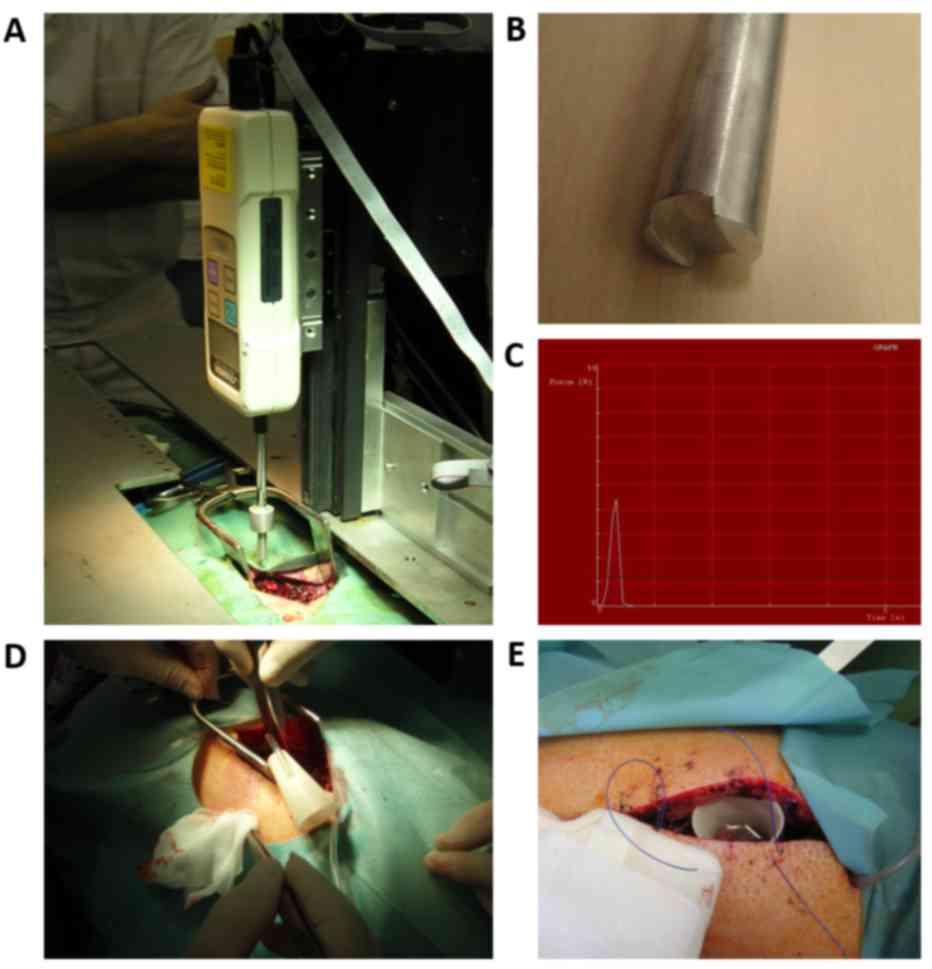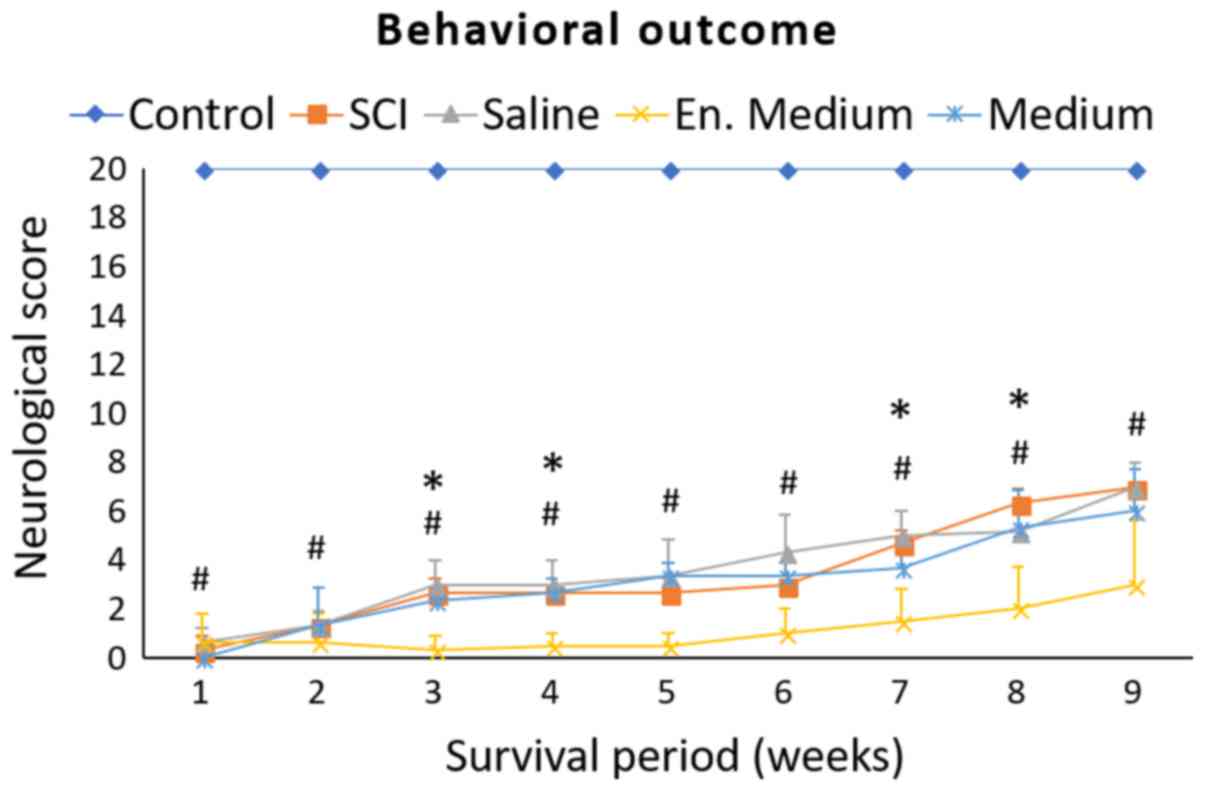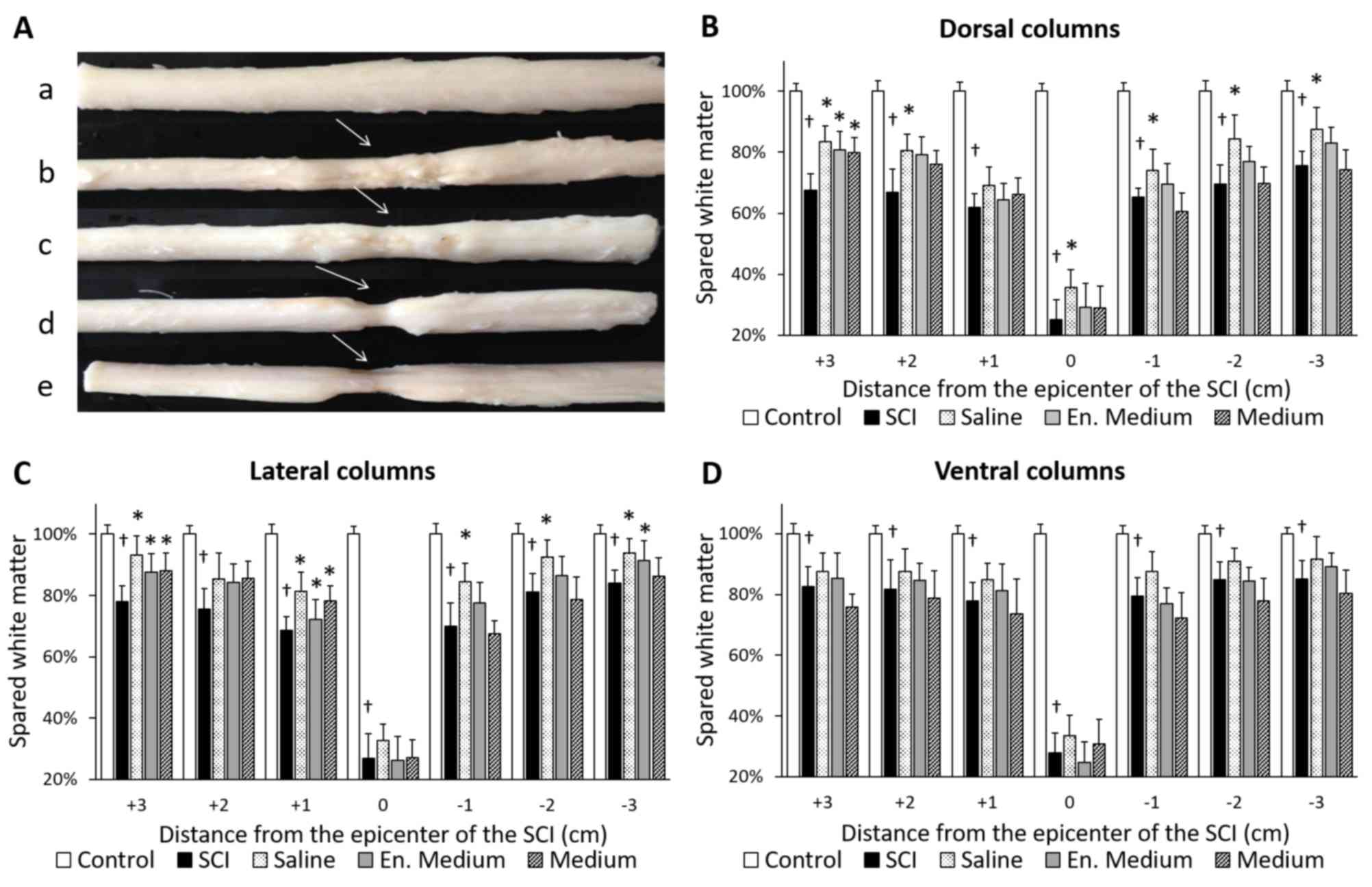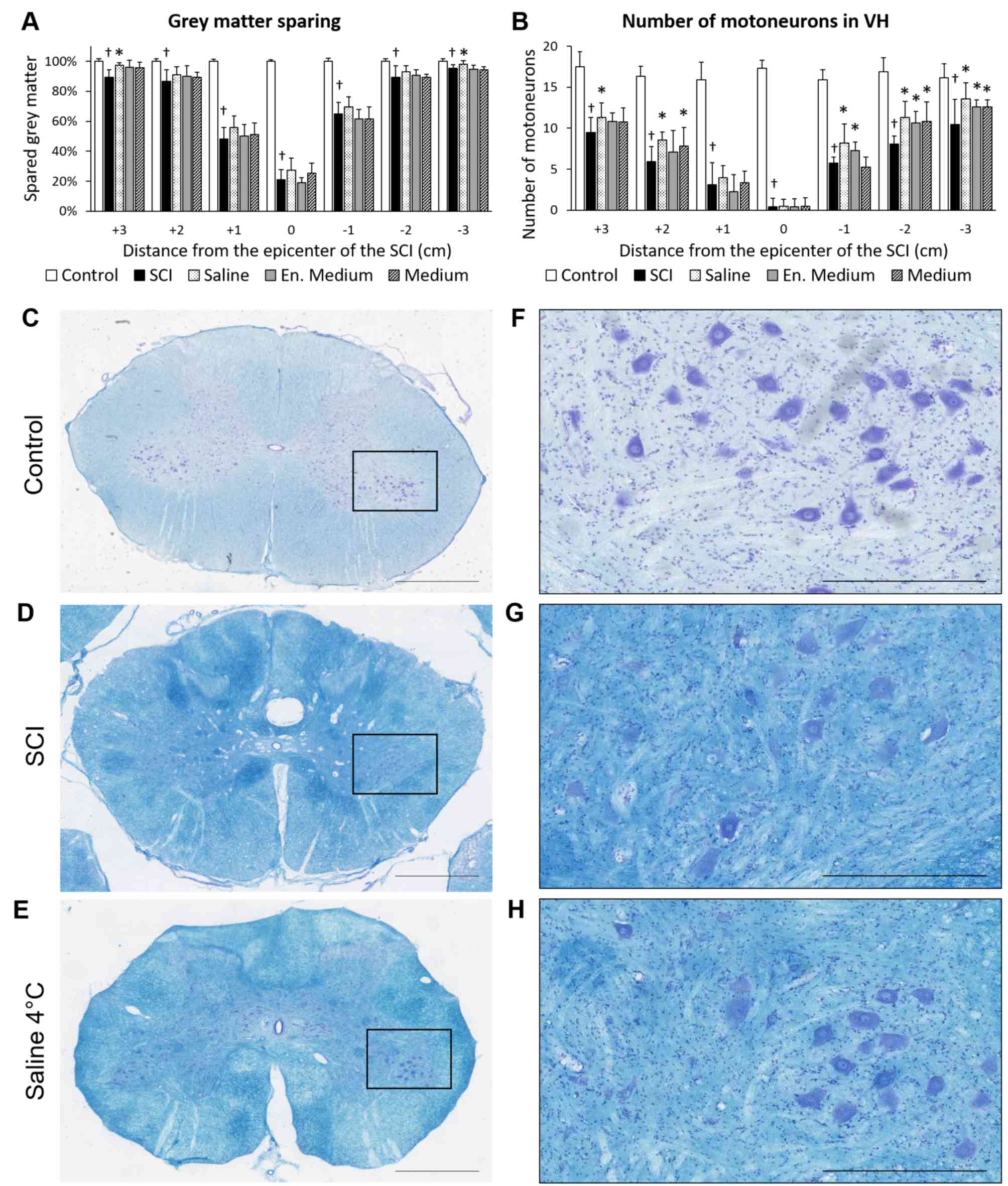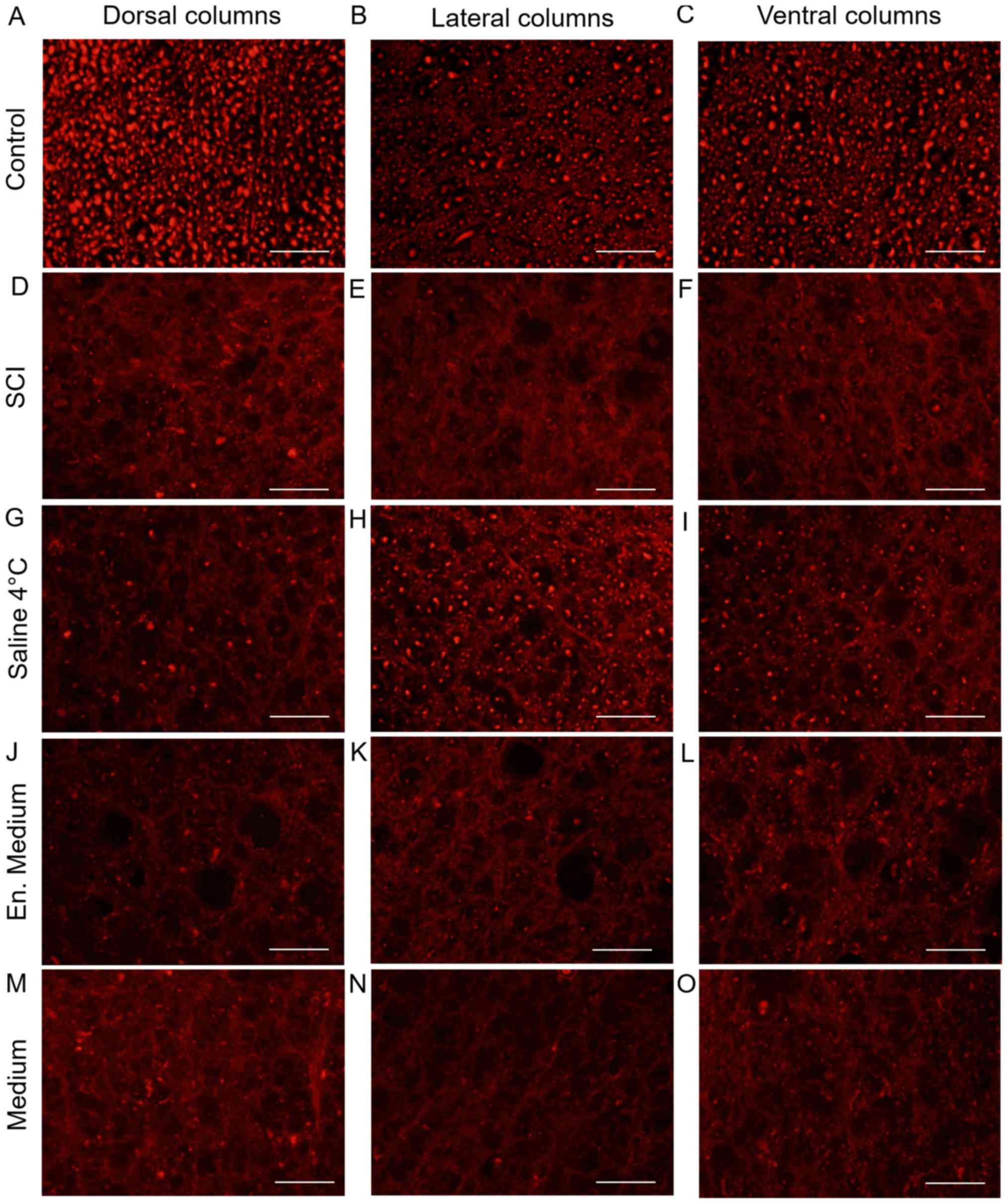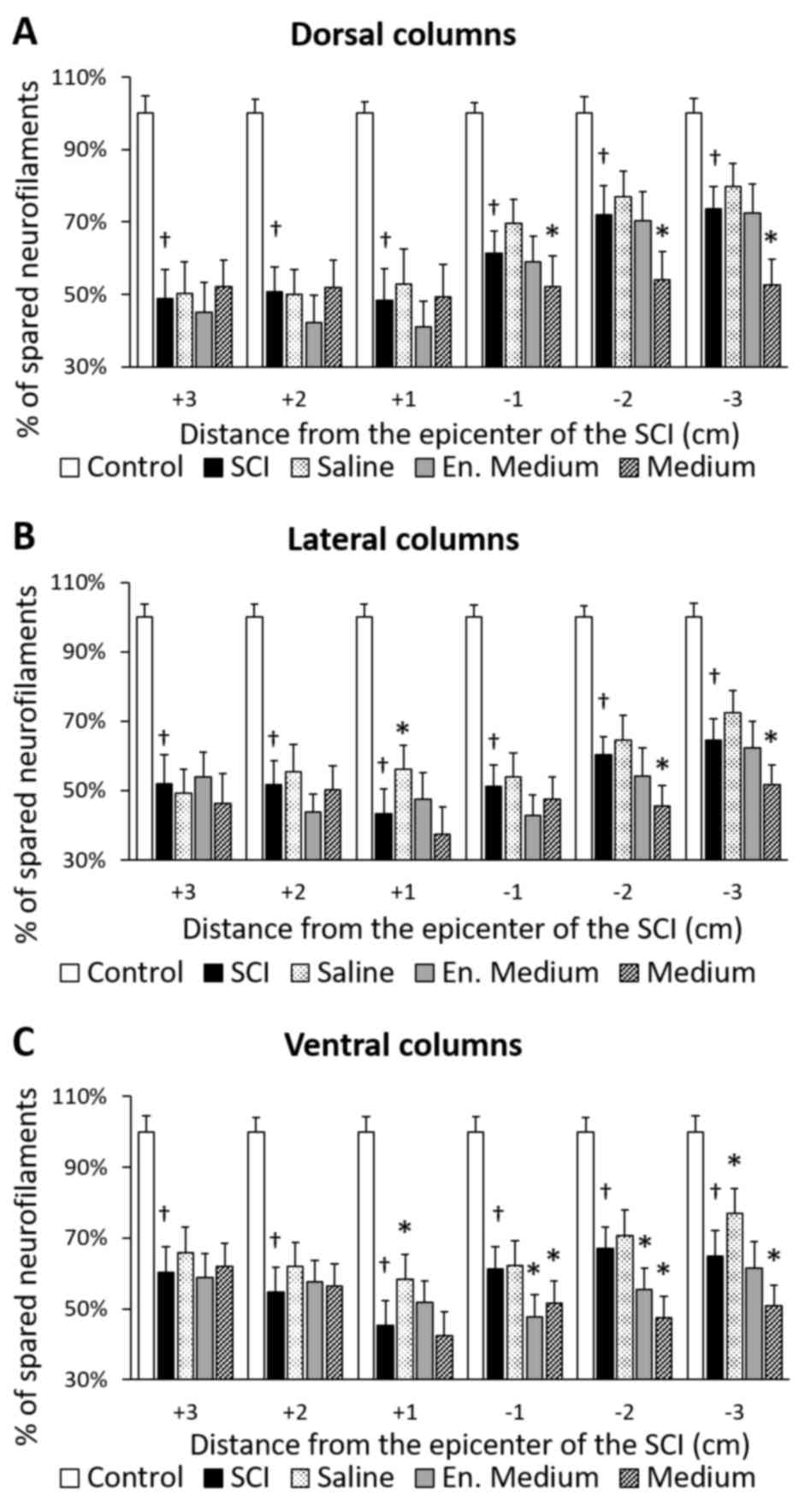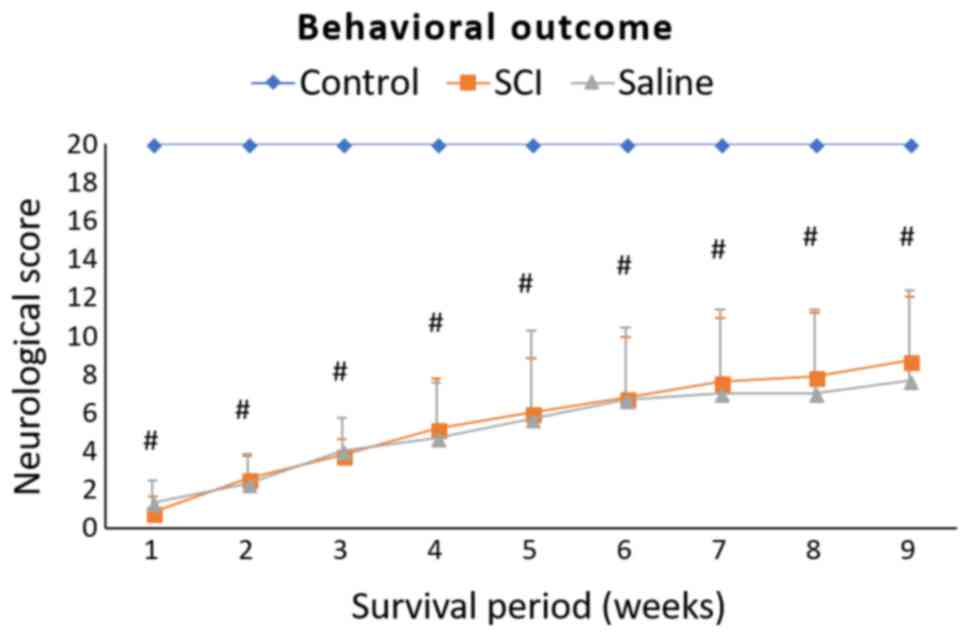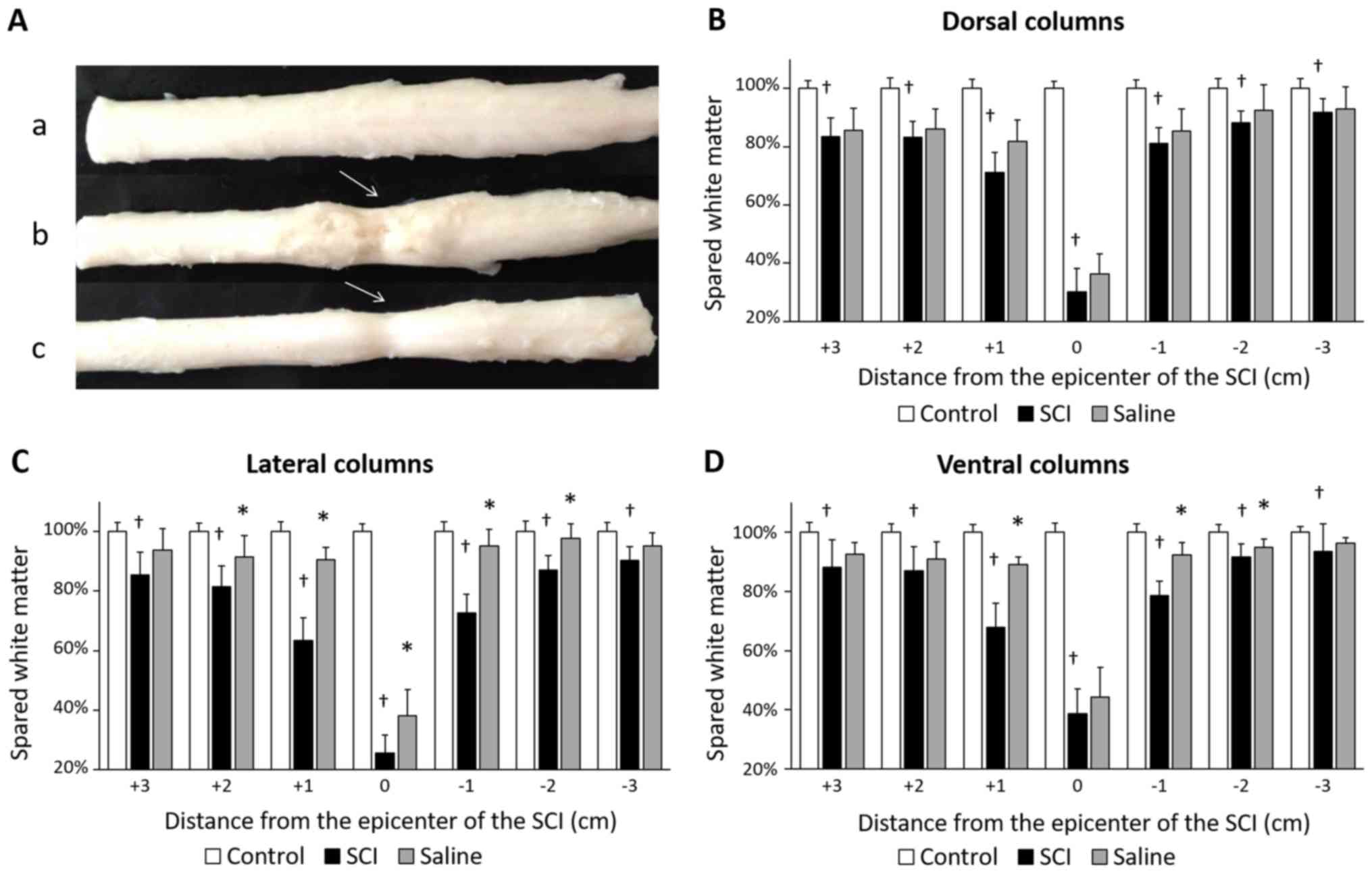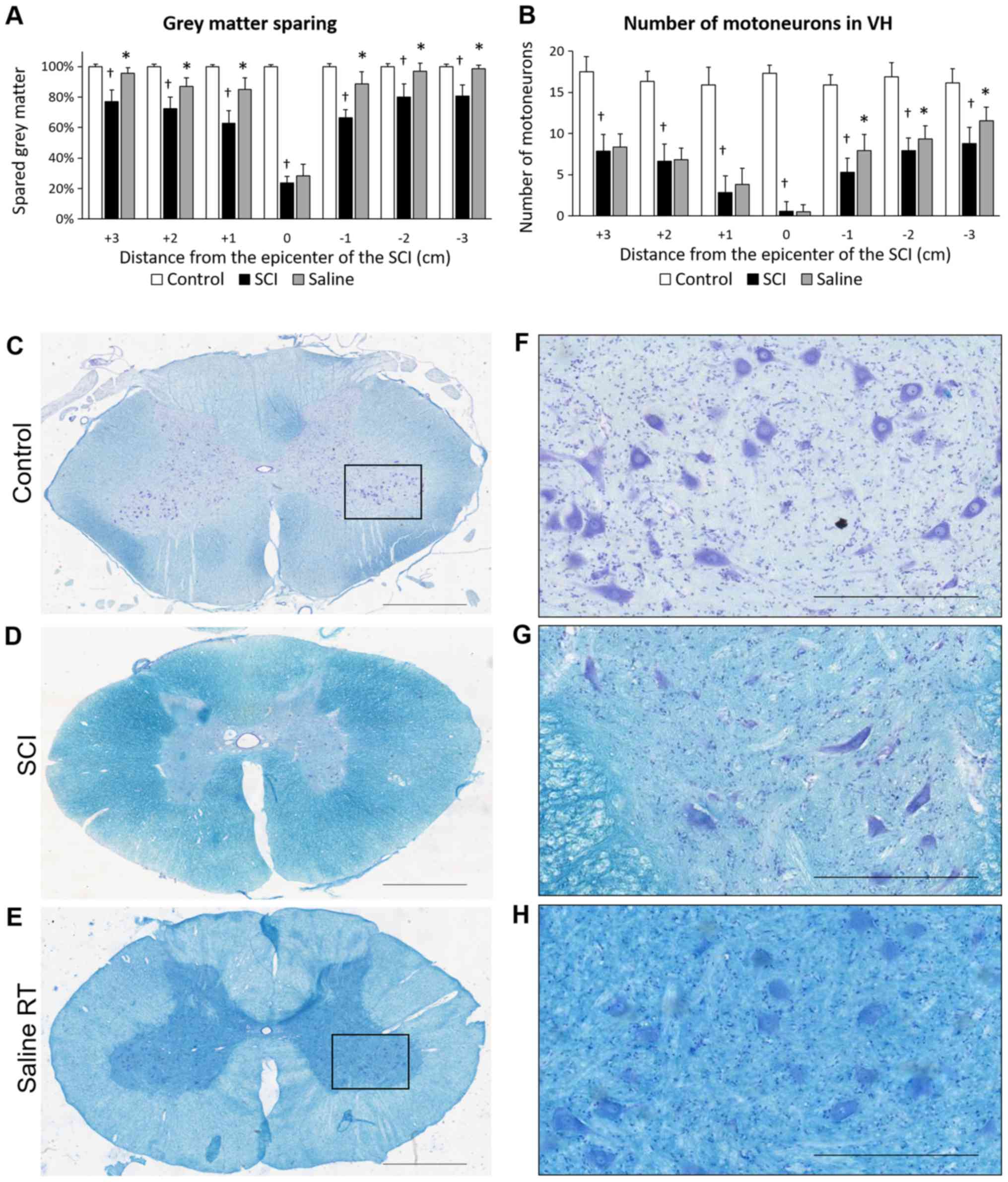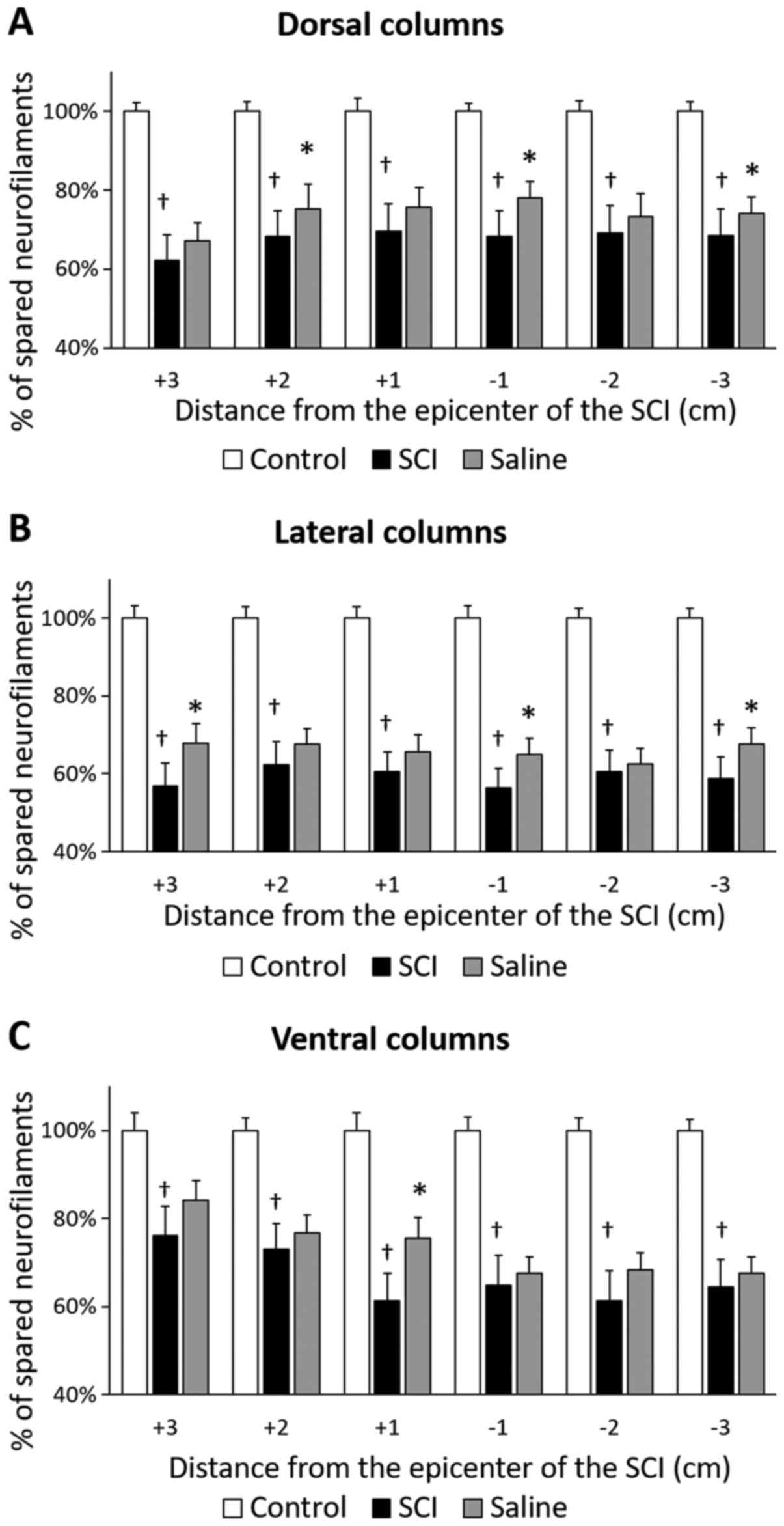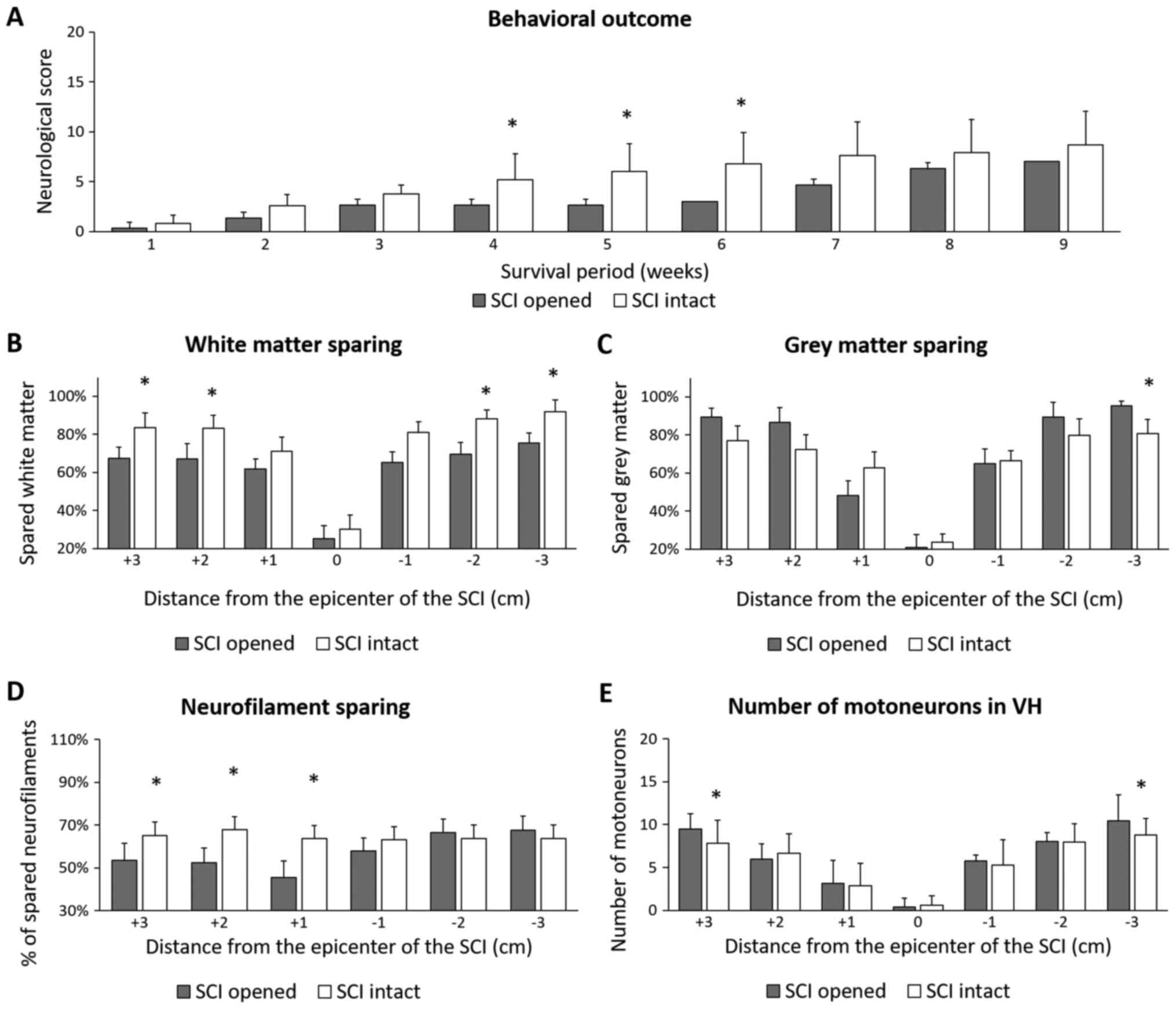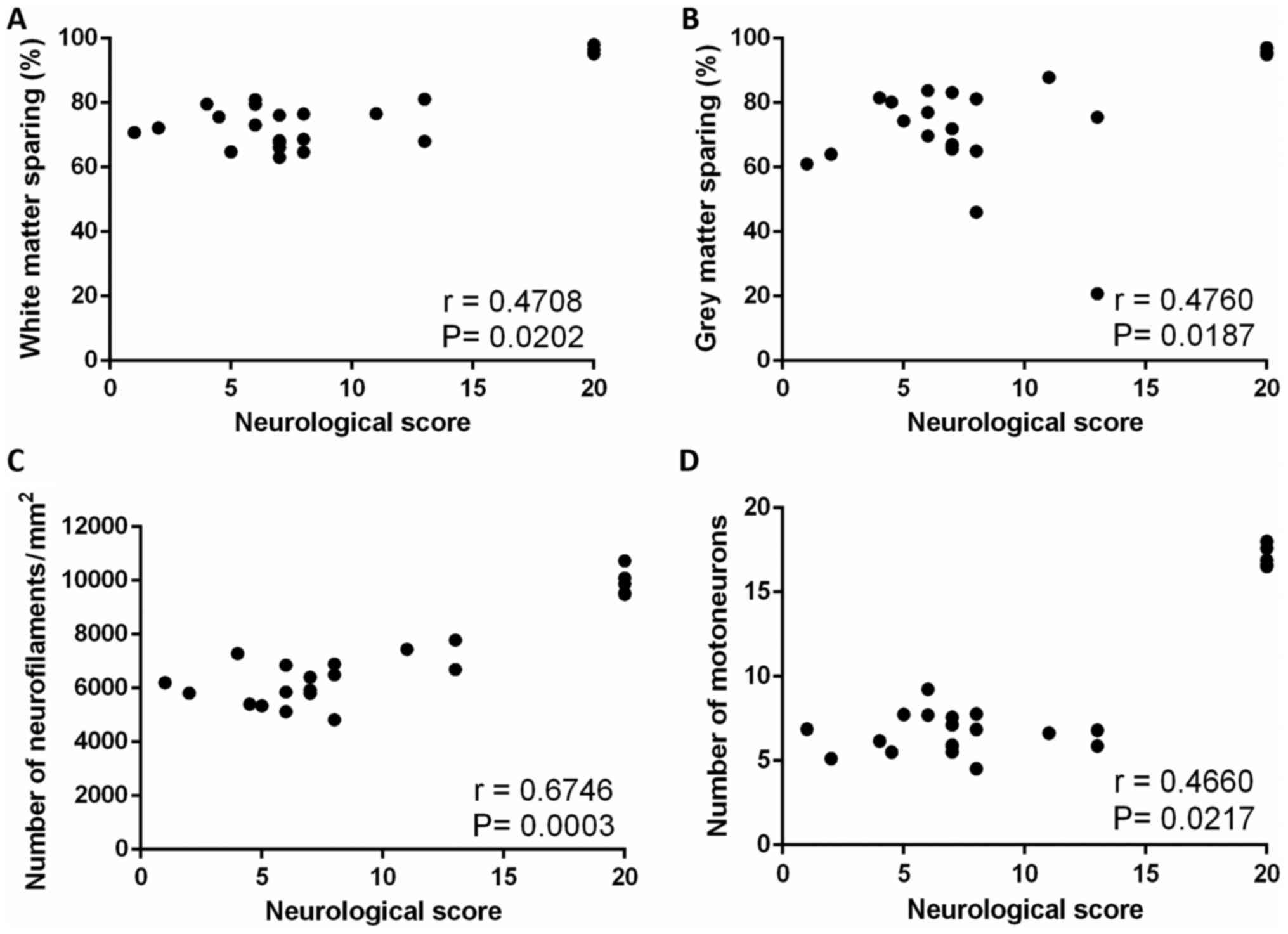|
1
|
Tator CH: Review of treatment trials in
human spinal cord injury: Issues, difficulties, and
recommendations. Neurosurgery. 59:957–987. 2006. View Article : Google Scholar : PubMed/NCBI
|
|
2
|
Tator CH: Update on the pathophysiology
and pathology of acute spinal cord injury. Brain Pathol. 5:407–413.
1995. View Article : Google Scholar : PubMed/NCBI
|
|
3
|
McDonald JW and Sadowsky C: Spinal-cord
injury. Lancet. 359:417–425. 2002. View Article : Google Scholar : PubMed/NCBI
|
|
4
|
Balentine JD: Pathology of experimental
spinal cord trauma. I. The necrotic lesion as a function of
vascular injury. Lab Invest. 39:236–253. 1978.PubMed/NCBI
|
|
5
|
Simard JM, Woo SK, Aarabi B and Gerzanich
V: The Sur1-Trpm4 channel in spinal cord injury. J Spine Suppl.
4:0022013.
|
|
6
|
Rowland JW, Hawryluk GW, Kwon B and
Fehlings MG: Current status of acute spinal cord injury
pathophysiology and emerging therapies: Promise on the horizon.
Neurosurg Focus. 25:E22008. View Article : Google Scholar : PubMed/NCBI
|
|
7
|
Bracken MB, Shepard MJ, Collins WF,
Holford TR, Young W, Baskin DS, Eisenberg HM, Flamm E, Leo-Summers
L, Maroon J, et al: A randomized, controlled trial of
methylprednisolone or naloxone in the treatment of acute
spinal-cord injury. Results of the Second National Acute Spinal
Cord Injury Study. N Engl J Med. 322:1405–1411. 1990. View Article : Google Scholar : PubMed/NCBI
|
|
8
|
Wang J and Pearse DD: Therapeutic
hypothermia in spinal cord injury: The status of its use and open
questions. Int J Mol Sci. 16:16848–16879. 2015. View Article : Google Scholar : PubMed/NCBI
|
|
9
|
Kwon BK, Okon E, Hillyer J, Mann C,
Baptiste D, Weaver LC, Fehlings M and Tetzlaff W: A systematic
review of non-invasive pharmacologic neuroprotective treatments for
acute spinal cord injury. J Neurotrauma. 28:1545–1588. 2011.
View Article : Google Scholar : PubMed/NCBI
|
|
10
|
Tetzlaff W, Okon EB, Karimi-Abdolrezaee S,
Hill CE, Sparling JS, Plemel JR, Plunet WT, Tsai EC, Baptiste D,
Smithson LJ, et al: A systematic review of cellular transplantation
therapies for spinal cord injury. J Neurotrauma. 28:1611–1682.
2011. View Article : Google Scholar : PubMed/NCBI
|
|
11
|
Wang B, Armstrong JS, Reyes M, Kulikowicz
E, Lee JH, Spicer D, Bhalala U, Yang ZJ, Koehler RC, Martin LJ and
Lee JK: White matter apoptosis is increased by delayed hypothermia
and rewarming in a neonatal piglet model of hypoxic ischemic
encephalopathy. Neuroscience. 316:296–310. 2016. View Article : Google Scholar : PubMed/NCBI
|
|
12
|
Martirosyan NL, Patel AA, Carotenuto A,
Kalani MY, Bohl MA, Preul MC and Theodore N: The role of
therapeutic hypothermia in the management of acute spinal cord
injury. Clin Neurol Neurosurg. 154:79–88. 2017. View Article : Google Scholar : PubMed/NCBI
|
|
13
|
Ok JH, Kim YH and Ha KY: Neuroprotective
effects of hypothermia after spinal cord injury in rats:
Comparative study between epidural hypothermia and systemic
hypothermia. Spine (Phila Pa 1976). 37:E1551–E1559. 2012.
View Article : Google Scholar : PubMed/NCBI
|
|
14
|
Ha KY and Kim YH: Neuroprotective effect
of moderate epidural hypothermia after spinal cord injury in rats.
Spine (Phila Pa 1976). 33:2059–2065. 2008. View Article : Google Scholar : PubMed/NCBI
|
|
15
|
Lo TP Jr, Cho KS, Garg MS, Lynch MS,
Marcillo AE, Koivisto DL, Stagg M, Abril RM, Patel S, Dietrich WD
and Pearse DD: Systemic hypothermia improves histological and
functional outcome after cervical spinal cord contusion in rats. J
Comp Neurol. 514:433–448. 2009. View Article : Google Scholar : PubMed/NCBI
|
|
16
|
Crowe MJ, Bresnahan JC, Shuman SL, Masters
JN and Beattie MS: Apoptosis and delayed degeneration after spinal
cord injury in rats and monkeys. Nat Med. 3:73–76. 1997. View Article : Google Scholar : PubMed/NCBI
|
|
17
|
Shuman SL, Bresnahan JC and Beattie MS:
Apoptosis of microglia and oligodendrocytes after spinal cord
contusion in rats. J Neurosci Res. 50:798–808. 1997. View Article : Google Scholar : PubMed/NCBI
|
|
18
|
Dumont RJ, Okonkwo DO, Verma S, Hurlbert
RJ, Boulos PT, Ellegala DB and Dumont AS: Acute spinal cord injury,
part I: Pathophysiologic mechanisms. Clin Neuropharmacol.
24:254–264. 2001. View Article : Google Scholar : PubMed/NCBI
|
|
19
|
Shibuya S, Miyamoto O, Janjua NA, Itano T,
Mori S and Norimatsu H: Posttraumatic moderate systemic hypothermia
reduces TUNEL positive cells following spinal cord injury in rat.
Spinal Cord. 42:29–34. 2004. View Article : Google Scholar : PubMed/NCBI
|
|
20
|
Dietrich WD, Atkins CM and Bramlett HM:
Protection in animal models of brain and spinal cord injury with
mild to moderate hypothermia. J Neurotrauma. 26:301–312. 2009.
View Article : Google Scholar : PubMed/NCBI
|
|
21
|
Grulova I, Slovinska L, Nagyova M, Cizek M
and Cizkova D: The effect of hypothermia on sensory-motor function
and tissue sparing after spinal cord injury. Spine J. 13:1881–1891.
2013. View Article : Google Scholar : PubMed/NCBI
|
|
22
|
Seo JY, Kim YH, Kim JW, Kim SI and Ha KY:
Effects of therapeutic hypothermia on apoptosis and autophagy after
spinal cord injury in rats. Spine (Phila Pa 1976). 40:883–890.
2015. View Article : Google Scholar : PubMed/NCBI
|
|
23
|
Strauch JT, Lauten A, Spielvogel D, Rinke
S, Zhang N, Weisz D, Bodian CA and Griepp RB: Mild hypothermia
protects the spinal cord from ischemic injury in a chronic porcine
model. Eur J Cardiothorac Surg. 25:708–715. 2004. View Article : Google Scholar : PubMed/NCBI
|
|
24
|
Yoshitake A, Mori A, Shimizu H, Ueda T,
Kabei N, Hachiya T, Okano H and Yozu R: Use of an epidural cooling
catheter with a closed countercurrent lumen to protectagainst
ischemic spinal cord injury in pigs. J Thorac Cardiovasc Surg.
134:1220–1226. 2007. View Article : Google Scholar : PubMed/NCBI
|
|
25
|
Inoue S, Mori A, Shimizu H, Yoshitake A,
Tashiro R, Kabei N and Yozu R: Combined use of an epidural cooling
catheter and systemic moderate hypothermia enhances spinal cord
protection against ischemic injury in rabbits. J Thorac Cardiovasc
Surg. 146:696–701. 2013. View Article : Google Scholar : PubMed/NCBI
|
|
26
|
Saito T, Saito S, Yamamoto H and Tsuchida
M: Neuroprotection following mild hypothermia after spinal cord
ischemia in rats. J Vasc Surg. 57:173–181. 2013. View Article : Google Scholar : PubMed/NCBI
|
|
27
|
Fay T: Early experiences with local and
generalized refrigeration of the human brain. J Neurosurg.
16:239–260. 1959. View Article : Google Scholar : PubMed/NCBI
|
|
28
|
Tuzgen S, Kaynar MY, Güner A, Gümüştaş K,
Belce A, Etuş V and Ozyurt E: The effect of epidural cooling on
lipid peroxidation after experimental spinal cord injury. Spinal
Cord. 36:654–657. 1998. View Article : Google Scholar : PubMed/NCBI
|
|
29
|
Kalayci M, Coskun O, Cagavi F, Kanter M,
Armutcu F, Gul S and Acikgoz B: Neuroprotective effects of ebselen
on experimental spinal cord injury in rats. Neurochem Res.
30:403–410. 2005. View Article : Google Scholar : PubMed/NCBI
|
|
30
|
Ji X, Luo Y, Ling F, Stetler RA, Lan J,
Cao G and Chen J: Mild hypothermia diminishes oxidative DNA damage
and pro-death signaling events after cerebral ischemia: A mechanism
for neuroprotection. Front Biosci. 12:1737–1747. 2007. View Article : Google Scholar : PubMed/NCBI
|
|
31
|
Duz B, Kaplan M, Bilgic S, Korkmaz A and
Kahraman S: Does hypothermic treatment provide an advantage after
spinal cord injury until surgery? An experimental study. Neurochem
Res. 34:407–410. 2009. View Article : Google Scholar : PubMed/NCBI
|
|
32
|
Topuz K, Colak A, Cemil B, Kutlay M,
Demircan MN, Simsek H, Ipcioglu O, Kucukodaci Z and Uzun G:
Combined hyperbaric oxygen and hypothermia treatment on oxidative
stress parameters after spinal cord injury: An experimental study.
Arch Med Res. 41:506–512. 2010. View Article : Google Scholar : PubMed/NCBI
|
|
33
|
Karamouzian S, Akhtarshomar S, Saied A and
Gholamhoseinian A: Effects of methylprednisolone on neuroprotective
effects of delay hypothermia on spinal cord injury in rat. Asian
Spine J. 9:1–6. 2015. View Article : Google Scholar : PubMed/NCBI
|
|
34
|
Wang D and Zhang J: Effects of hypothermia
combined with neural stem cell transplantation on recovery of
neurological function in rats with spinal cord injury. Mol Med Rep.
11:1759–1767. 2015. View Article : Google Scholar : PubMed/NCBI
|
|
35
|
Xu X, Li N, Zhu L, Zhou Y and Cheng H:
Beneficial effects of local profound hypothermia and the possible
mechanism after experimental spinal cord injury in rats. J Spinal
Cord Med. 39:220–228. 2015. View Article : Google Scholar : PubMed/NCBI
|
|
36
|
Morino T, Ogata T, Takeba J and Yamamoto
H: Microglia inhibition is a target of mild hypothermic treatment
after the spinal cord injury. Spinal Cord. 46:425–431. 2008.
View Article : Google Scholar : PubMed/NCBI
|
|
37
|
Horiuchi T, Kawaguchi M, Kurita N, Inoue
S, Nakamura M, Konishi N and Furuya H: The long-term effects of
mild to moderate hypothermia on gray and white matter injury after
spinal cord ischemia in rats. Anesth Analg. 109:559–566. 2009.
View Article : Google Scholar : PubMed/NCBI
|
|
38
|
Levi AD, Green BA, Wang MY, Dietrich WD,
Brindle T, Vanni S, Casella G, Elhammady G and Jagid J: Clinical
application of modest hypothermia after spinal cord injury. J
Neurotrauma. 26:407–415. 2009. View Article : Google Scholar : PubMed/NCBI
|
|
39
|
Ahmad FU, Wang MY and Levi AD: Hypothermia
for acute spinal cord injury-a review. World Neurosurg. 82:207–214.
2014. View Article : Google Scholar : PubMed/NCBI
|
|
40
|
Casas CE, Herrera LP, Prusmack C, Ruenes
G, Marcillo A and Guest JD: Effects of epidural hypothermic saline
infusion on locomotor outcome and tissue preservation after
moderate thoracic spinal cord contusion in rats. J Neurosurg Spine.
2:308–318. 2005. View Article : Google Scholar : PubMed/NCBI
|
|
41
|
Morochovic R, Chudá M, Talánová J, Cibur
P, Kitka M and Vanický I: Local transcutaneous cooling of the
spinal cord in the rat: Effects on long-term outcomes after
compression spinal cord injury. Int J Neurosci. 118:555–568. 2008.
View Article : Google Scholar : PubMed/NCBI
|
|
42
|
Morizane K, Ogata T, Morino T, Horiuchi H,
Yamaoka G, Hino M and Miura H: A novel thermoelectric cooling
device using Peltier modules for inducing local hypothermia of the
spinal cord: The effect of local electrically controlled cooling
for the treatment of spinal cord injuries in conscious rats.
Neurosci Res. 72:279–282. 2012. View Article : Google Scholar : PubMed/NCBI
|
|
43
|
Barbosa MO, Cristante AF, Santos GB,
Ferreira R, Marcon RM and Barros Filho TE: Neuroprotective effect
of epidural hypothermia after spinal cord lesion in rats. Clinics
(Sao Paulo). 69:559–564. 2014. View Article : Google Scholar : PubMed/NCBI
|
|
44
|
Albin MS, White RJ, Locke GS, Massopust LC
Jr and Kretchmer HE: Localized spinal cord hypthermia-anesthetic
effects and application to spinal cord injury. Anesth Analg.
46:8–16. 1967.PubMed/NCBI
|
|
45
|
Negrin J Jr: Spinal cord hypothermia in
the neurosurgical management of the acute and chronic
post-traumatic paraplegic patient. Paraplegia. 10:336–343. 1973.
View Article : Google Scholar : PubMed/NCBI
|
|
46
|
Yashon D, Vise WM, Dewey RC and Hunt WE:
Temperature of the spinal cord during local hypothermia in dogs. J
Neurosurg. 39:742–745. 1973. View Article : Google Scholar : PubMed/NCBI
|
|
47
|
Dimar JR, Shields CB, Zhang YP, Burke DA,
Raque GH and Glassman SD: The role of directly applied hypothermia
in spinal cord injury. Spine (Phila Pa 1976). 25:2294–2302. 2000.
View Article : Google Scholar : PubMed/NCBI
|
|
48
|
Chatzipanteli K, Yanagawa Y, Marcillo AE,
Kraydieh S, Yezierski RP and Dietrich WD: Posstraumatic hypothermia
reduced polymorphonuclear leukocyte accumulation following spinal
cord injury in rats. J Neurotrauma. 17:321–332. 2000. View Article : Google Scholar : PubMed/NCBI
|
|
49
|
Cappuccino A, Bisson LJ, Carpenter B,
Marzo J, Dietrich WD and Cappuccino H: The use of systemic
hypothermia for the treatment of an acute cervical spinal cord
injury in a professional football player. Spine (Phila Pa 1976).
35:E57–E62. 2010. View Article : Google Scholar : PubMed/NCBI
|
|
50
|
Levi AD, Casella G, Green BA, Dietrich WD,
Vanni S, Jagid J and Wang MY: Clinical outcomes using modest
intravascular hypothermia after acute cervical spinal cord injury.
Neurosurgery. 66:670–677. 2010. View Article : Google Scholar : PubMed/NCBI
|
|
51
|
Albin MS, White RJ, Yashon D and Harris
LS: Effects of localized cooling on spinal cord trauma. J Trauma.
9:1000–1008. 1969. View Article : Google Scholar : PubMed/NCBI
|
|
52
|
Black P and Markowitz RS: Experimental
spinal cord injury in monkeys: Comparison of steroids and local
hypothermia. Surg Forum. 22:409–411. 1971.PubMed/NCBI
|
|
53
|
Dididze M, Green BA, Dietrich WD, Vanni S,
Wang MY and Levi AD: Systemic hypothermia in acute cervical spinal
cord injury: A case-controlled study. Spinal Cord. 51:395–400.
2013. View Article : Google Scholar : PubMed/NCBI
|
|
54
|
MacLaren R, Gallagher J, Shin J, Varnado S
and Nguyen L: Assessment of adverse events and predictors of
neurological recovery after therapeutic hypothermia. Ann
Pharmacother. 48:17–25. 2014. View Article : Google Scholar : PubMed/NCBI
|
|
55
|
Hansebout RR and Hansebout CR: Local
cooling for traumatic spinal cord injury: Outcomes in 20 patients
and review of the literature. J Neurosurg Spine. 20:550–561. 2014.
View Article : Google Scholar : PubMed/NCBI
|
|
56
|
Navarro R, Juhas S, Keshavarzi S, Juhasova
J, Motlik J, Johe K, Marsala S, Scadeng M, Lazar P, Tomori Z, et
al: Chronic spinal compression model in minipigs: A systematic
behavioral, qualitative, and quantitative neuropathological study.
J Neurotrauma. 29:499–513. 2012. View Article : Google Scholar : PubMed/NCBI
|
|
57
|
Gedrova S, Galik J, Marsala M, Zavodska M,
Pavel J, Sulla I, Gajdos M, Lukac I, Kafka J, Ledecky V, et al:
Neuroprotective effect of local hypothermia in a
computer-controlled compression model in minipig: Correlation of
tissue sparing along the rostro-caudal axis with neurological
outcome. Exp Ther Med. 15:254–270. 2018.PubMed/NCBI
|
|
58
|
Sulla I, Boldizar M, Racekova E and Balik
V: Experience with a thoracic laminectomy in minipigs. Folia
Veterinaria. 56:35–39. 2012.
|
|
59
|
Lim SN, Gladman SJ, Dyall SC, Patel U,
Virani N, Kang JX, Priestley JV and Michael-Titus AT: Transgenic
mice with high endogenous omega-3 fatty acids are protected from
spinal cord injury. Neurobiol Dis. 51:104–112. 2013. View Article : Google Scholar : PubMed/NCBI
|
|
60
|
Tator CH and Fehlings MG: Review of the
secondary injury theory of acute spinal cord trauma with emphasis
on vascular mechanisms. J Neurosurg. 75:15–26. 1991. View Article : Google Scholar : PubMed/NCBI
|
|
61
|
Rosenfeld JF, Vaccaro AR, Albert TJ, Klein
GR and Cotler JM: The benefits of early decompression in cervical
spinal cord injury. Am J Orthop (Belle Mead NJ). 27:23–28.
1998.PubMed/NCBI
|
|
62
|
Fehlings MG and Perrin RG: The timing of
surgical intervention in the treatment of spinal cord injury: A
systematic review of recent clinical evidence. Spine (Phila Pa
1976). 31 (11 Suppl):S28–S36. 2006. View Article : Google Scholar : PubMed/NCBI
|
|
63
|
Smith JS, Anderson R, Pham T, Bhatia N,
Steward O and Gupta R: Role of early surgical decompression of the
intradural space after cervical spinal cord injury in an animal
model. J Bone Joint Surg Am. 92:1206–1214. 2010. View Article : Google Scholar : PubMed/NCBI
|
|
64
|
Perkins PG and Deane RH: Long-term
follow-up of six patients with acute spinal injury following dural
decompression. Injury. 19:397–401. 1988. View Article : Google Scholar : PubMed/NCBI
|
|
65
|
Phang I, Werndle MC, Saadoun S, Varsos G,
Czosnyka M, Zoumprouli A and Papadopoulos MC: Expansion duroplasty
improves intraspinal pressure, spinal cord perfusion pressure, and
vascular pressure reactivity index in patients with traumatic
spinal cord injury: Injured spinal cord pressure evaluation study.
J Neurotrauma. 32:865–874. 2015. View Article : Google Scholar : PubMed/NCBI
|
|
66
|
Kong CY, Hosseini AM, Belanger LM, Ronco
JJ, Paquette SJ, Boyd MC, Dea N, Street J, Fisher CG, Dvorak MF and
Kwon BK: A prospective evaluation of hemodynamic management in
acute spinal cord injury patients. Spinal Cord. 51:466–471. 2013.
View Article : Google Scholar : PubMed/NCBI
|
|
67
|
Iannotti C, Zhang YP, Shields LB, Han Y,
Burke DA, Xu XM and Shields CB: Dural repair reduces connective
tissue scar invasion and cystic cavity formation after acute spinal
cord laceration injury in adult rats. J Neurotrauma. 23:853–865.
2006. View Article : Google Scholar : PubMed/NCBI
|
|
68
|
Desai A, Ball PA, Bekelis K, Lurie J,
Mirza SK, Tosteson TD and Weinstein JN: SPORT: Does incidental
durotomy affect long-term outcomes in cases of spinal stenosis?
Neurosurgery. 69:38–44. 2011. View Article : Google Scholar : PubMed/NCBI
|
|
69
|
Jones CF, Cripton PA and Kwon BK: Gross
morphological changes of the spinal cord immediately after surgical
decompression in a large animal model of traumatic spinal cord
injury. Spine (Phila Pa 1976). 37:E890–E899. 2012. View Article : Google Scholar : PubMed/NCBI
|
|
70
|
Jones CF, Newell RS, Lee JH, Cripton PA
and Kwon BK: The pressure distribution of cerebrospinal fluid
responds to residual compression and decompression in an animal
model of acute spinal cord injury. Spine (Phila Pa 1976).
37:E1422–E1431. 2012. View Article : Google Scholar : PubMed/NCBI
|
|
71
|
Schumacher PA, Siman RG and Fehlings MG:
Pretreatment with calpain inhibitor CEP-4143 inhibits calpain I
activation and cytoskeletal degradation, improves neurological
function, and enhances axonal survival after traumatic spinal cord
injury. J Neurochem. 74:E1646–E1655. 2000. View Article : Google Scholar
|
|
72
|
Nishida F, Sisti MS, Zanuzzi CN, Barbeito
CG and Portiansky EL: Neurons of the rat cervical spinal cord
express vimentin and neurofilament after intraparenchymal injection
of kainic acid. Neurosci Lett. 643:103–110. 2017. View Article : Google Scholar : PubMed/NCBI
|
|
73
|
Lépinoux-Chambaud C and Eyer J: Review on
intermediate filaments of the nervous system and their pathological
alterations. Histochem Cell Biol. 140:13–22. 2013. View Article : Google Scholar : PubMed/NCBI
|
|
74
|
Wang H, Wu M, Zhan C, Ma E, Yang M, Yang X
and Li Y: Neurofilament proteins in axonal regeneration and
neurodegenerative diseases. Neural Regen Res. 7:620–626.
2012.PubMed/NCBI
|
|
75
|
Greig A, Donevan SD, Mujtaba TJ, Parks TN
and Rao MS: Characterization of the AMPA-activated receptors
present on motoneurons. J Neurochem. 74:179–191. 2000. View Article : Google Scholar : PubMed/NCBI
|
|
76
|
Vandenberghe W, Ihle EC, Patneau DK,
Robberecht W and Brorson JR: AMPA receptor current density, not
desensitization, predicts selective motoneuron vulnerability. J
Neurosci. 20:7158–7166. 2000. View Article : Google Scholar : PubMed/NCBI
|
|
77
|
Van Den Bosch L and Robberecht W:
Different receptors mediate motor neuron death induced by short and
long exposures to excitotoxicity. Brain Res Bull. 53:383–388. 2000.
View Article : Google Scholar : PubMed/NCBI
|
|
78
|
Lukáčová N, Kisucká A, Pavel J, Hricová L,
Kucharíková A, Gálik J, Maršala M, Langfort J and Chalimoniuk M:
Spinal cord transection modifies neuronal nitric oxide synthase
expression in medullar reticular nuclei and in the spinal cord and
increases parvalbumin immunopositivity in motoneurons below the
site of injury in experimental rabbits. Acta Histochem.
114:518–524. 2012. View Article : Google Scholar : PubMed/NCBI
|
|
79
|
Gillinov AM, Redmond JM, Zehr KJ, Troncoso
JC, Arroyo S, Lesser RP, Lee AW, Stuart RS, Reitz BA and
Baumgartner WA: Superior cerebral protection with profound
hypothermia during circulatory arrest. Ann Thorac Surg.
55:1432–1439. 1993. View Article : Google Scholar : PubMed/NCBI
|
|
80
|
Mezrow CK, Midulla PS, Sadeghi AM, Gandsas
A, Wang W, Dapunt OE, Zappulla R and Griepp RB: Evaluation of
cerebral metabolism and quantitative electroencephalography after
hypothermic circulatory arrest and low-flow cardiopulmonary bypass
at different temperatures. J Thorac Cardiovasc Surg. 107:1006–1019.
1994.PubMed/NCBI
|
|
81
|
Lima B, Williams JB, Bhattacharya SD, Shah
AA, Andersen N, Gaca JG and Hughes GC: Results of proximal arch
replacement using deep hypothermia for circulatory arrest: Is
moderate hypothermia really justifiable? Am Surg. 77:1438–1444.
2011.PubMed/NCBI
|
|
82
|
Vanický I, Marsala M, Gálik J and Marsala
J: Epidural perfusion cooling protection against protracted spinal
cord ischemia in rabbits. J Neurosurg. 79:736–741. 1993. View Article : Google Scholar : PubMed/NCBI
|
|
83
|
Lucas JH, Wang GF and Gross GW: NMDA
antagonists prevent hypothermic injury and death of mammalian
spinal neurons. J Neurotrauma. 7:229–236. 1990. View Article : Google Scholar : PubMed/NCBI
|
|
84
|
Romero-Sierra C, Hansebout R, Sierhuis A
and Lewin M: A new method for localized spinal cord cooling. Med
Biol Enf. 12:188–193. 1974. View Article : Google Scholar
|
|
85
|
Marsala M, Vanicky I, Galik J, Radonak J,
Kundrat I and Marsala J: Panmyelic epidural cooling protects
against ischemic spinal cord damage. J Surg Res. 55:21–31. 1993.
View Article : Google Scholar : PubMed/NCBI
|
|
86
|
Marsala M, Galik J, Ishikawa T and Yaksh
TL: Technique of selective spinal cord cooling in rat: Methodology
and application. J Neurosci Methods. 74:97–106. 1997. View Article : Google Scholar : PubMed/NCBI
|
|
87
|
Teh DBL, Chua SM, Prasad A, Kakkos I,
Jiang W, Yue M, Liu X and All AH: Neuroprotective assessment of
prolonged local hypothermia post contusive spinal cord injury in
rodent model. Spine J. 18:507–514. 2018. View Article : Google Scholar : PubMed/NCBI
|
|
88
|
Camara AK, Riess ML, Kevin LG, Novalija E
and Stowe DF: Hypothermia augments reactive oxygen species detected
in the guinea pig isolated perfused heart. Am J Physiol Heart Circ
Physiol. 286:H1289–H1299. 2004. View Article : Google Scholar : PubMed/NCBI
|















